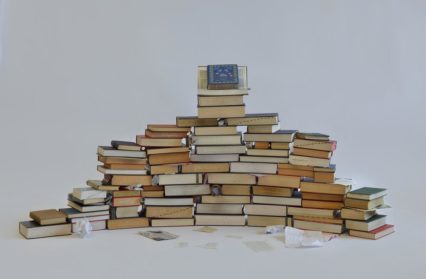Josie Cray explores the Literary Atlas Wales, a dynamic exhibition of new work at the Pierhead in Cardiff Bay representing a different kind of map.
A standard map will show you certain information about the spaces around you: an arrow will point might point to true north; a scale on the side will let you roughly estimate how far you have left of your journey; contour lines will represent the rise and fall of the land. Some maps may be colourful, others in black and white. Ultimately, standard maps allow us to make sense of the spaces and places around us. But is there a way of reimagining what maps might reveal to us about the world around us? Might they open a conversation about the interaction between nature and humans, between place and identity?
One project asks such a question. Literary Atlas Wales—an AHRC-funded project which features collaboration between universities, creative writers, artists, and libraries in Wales—is asking us to rethink our connection to place in relation to our experience of location in novels. At its core, Literary Atlas Wales is an interactive online atlas of English-language novels set in Wales. Yet it moves beyond just placing pins on a map by exploring ‘fresh insights into the ways literature plays its part in the connection between who we are as individuals and groups, and the geographical locations which help to shape these identities.’ The project reconceptualises our understanding of place and of identity in relation to place by developing ‘distant’ maps and ‘deep’ maps as well as commissioning artistic ‘maps’ of their carefully selected novels set in Wales.
Currently displayed at The Pierhead, Cardiff Bay, are twelve pieces of artwork commissioned and inspired by twelve English-language novels set in Wales. Mediums range from video to sketching and drawings, sculptures and metalwork offering intriguing insight into the human connection to place found in literature. As artist Amy Sterling notes in relation to her work ‘The Missing Piece/Y darn Sydd ar Goll’, the project ‘forces one to think about the nature of fiction and its place in the real world and how it connects with the way we imagine the story we are reading’.

Joni Smith’s collage-like piece ‘Concrete Ribbon Road’ is a reaction to Lloyd Jones’ novel Mr Vogel. Smith uses the symbols and elements of a range of maps to re-map Wales including a constellation map, a globe, and what appears to be topographical mappings. Wales becomes horizontal, made up of fragments of objects meant to make sense of the land around us. Smith refers to a quote by Jones who referred to the books as a ‘Spaghetti Junction’ of ideas, and the collage takes full advantage of the chaotic nature of ideas and writing and refiguring the world around us. Anglesey and its roads are interspersed with ‘castles/sheep/lighthouses’ slotted into each nook and crevice of the land. ‘Concrete Ribbon Road’ appropriates images and symbols from maps to reproduce a new vision of Wales in all its chaos. Referencing Henry James’s quote ‘chaos was the law of nature, order was the dream of man,’ Smith wanted to show Wales ‘revelling in chaos’ through the inchoate collage of vibrant colours and miniscule symbolism.
Moving away from traditional forms and images of cartography is John Abell’s enormous and vibrant ‘Hiraeth for Beginners’. Bright reds set against black and pale blues capture Abell’s desire to present a visual interpretation of ‘denouement on Penmon beach’ in Tristan Hughes’ Revenant. Withered bodies and abstract figures populate this piece which seeks to work both in conjunction with the novel and as a separate piece offering an exciting way of connecting place with plot. Etchings reveal a harshness and reality sits alongside the mythical, and in some instances, abstract. The image, though not made up of map symbols as in Smith’s, does present lines of separation, spaces and places divided and connected via overlapping images and contracting colours with form a feast for the eyes.

Moving beyond the two-dimensional, Amy Sterly’s sculptural piece is made out of dictionaries, books, scraps, keepsakes and other ephemera. The wall of books can be read two ways: a divide of two spaces, and a connection between English and Welsh, between place and identity. Chalked onto the books (or possibly through the use of an eraser to remove top dirt) are words, both Welsh and English: disbyddu, collateral, geiriau, apathetic. These words ‘weave into a tapestry’ and represent the way words form and sit in our mouths and the mouths of Alys Conran’s characters. Train ticket stubs are slotted between book, fragments of sheet music litter the floor with newspapers as this piece is both built firmly attached to the ground and rises up into space to suggest possibilities of the way we think about nature, fiction, place, and stories.
There are standard maps which take us from A to B, and then there are these maps which ask us to consider our journey, our connection between nature and our identities, between the Wales around us, in literature, and in us.
There are nine other pieces inspired and in conversation with nine English-language novels set in Wales on display alongside those above, each exploring and mapping a literary Wales.
You can explore Literary Atlas Wales’ resources, artwork, novels and more here.
You might also like…
Josie Cray reviews the Welsh artist Claudia Williams retrospective at the Martin Tinney Gallery in Cardiff. Her work often captures moments of everyday activities.
Josie Cray is a contributor to Wales Arts Review.



 Enjoyed this article? Support our writers directly by buying them a coffee and clicking this link.
Enjoyed this article? Support our writers directly by buying them a coffee and clicking this link.








